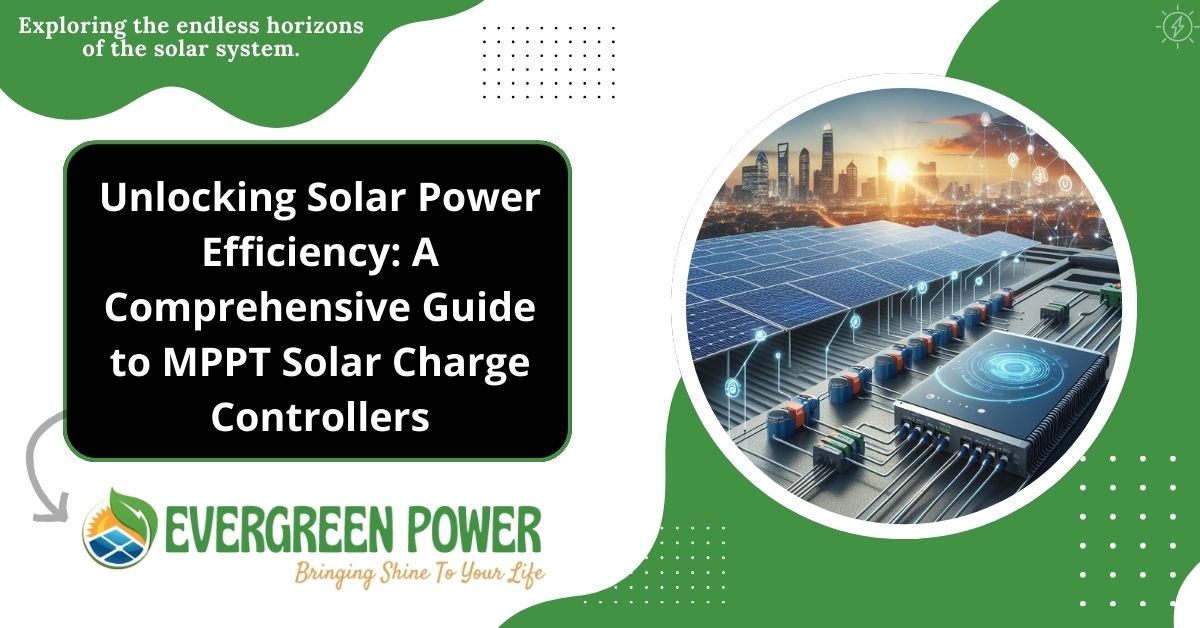Dive deep into the world of MPPT solar charge controllers with our comprehensive guide. Learn how these advanced devices maximize solar power efficiency, reduce costs, and contribute to sustainable energy solutions.
In an era where sustainable energy solutions are paramount, the harnessing of solar power stands out as a beacon of hope. At the heart of any successful solar power system lies the MPPT (Maximum Power Point Tracking) solar charge controller. This guide aims to illuminate the intricacies of MPPT controllers, shedding light on their operation, benefits, and how to select the perfect one for your solar setup.

Understanding MPPT Solar Charge Controllers:
MPPT solar charge controllers are intelligent devices designed to optimize the performance of solar panels. Unlike traditional PWM controllers, which regulate the flow of energy in a less efficient manner, MPPT controllers dynamically adjust voltage and current levels to ensure that solar panels operate at their maximum power point (MPP). By continuously tracking changes in environmental conditions, such as sunlight intensity and temperature, MPPT controllers maximize energy harvesting, leading to significant efficiency gains.
- Maximum Power Point Tracking (MPPT): Solar panel output fluctuates depending on sunlight intensity and temperature. The MPPT controller constantly monitors these parameters and adjusts the electrical connection between the panels and batteries to ensure the panels operate at their “maximum power point” – the point where they generate the most power under varying conditions.
- Battery protection: MPPT controllers prevent overcharging and deep discharging of your batteries, extending their lifespan. They regulate the charging voltage and current based on the battery type and health.
- System monitoring: Many MPPT controllers offer valuable data on system performance, including solar panel output, battery voltage, and charging current. This information allows you to optimize your system and troubleshoot any issues.
How Does an MPPT Solar Charge Controllers Work?
At the core of an MPPT controller lies a sophisticated algorithm that calculates the optimal operating point for solar panels in real time. By varying the electrical load, MPPT controllers ensure that solar panels operate at their peak efficiency regardless of external factors. This dynamic adjustment of voltage and current allows for the extraction of maximum power from the solar array, thus maximizing energy output.
Why Use an MPPT Solar Charge Controllers?
Compared to traditional PWM (Pulse Width Modulation) charge controllers, MPPT controllers offer significant advantages:
- Increased Energy Harvest: MPPT controllers can extract up to 30-40% more power from your solar panels compared to PWM controllers, especially in non-ideal conditions like partial shade or fluctuating temperatures. This translates to faster battery charging times and more usable solar energy.
- Improved System Efficiency: By maximizing power output, MPPT controllers allow you to utilize a smaller solar panel array to achieve your desired energy needs. This translates to cost savings on upfront equipment investment.
- Longer Battery Life: Precise charging regulation by MPPT controllers prevents battery damage from overcharging or deep discharging, extending battery lifespan.

Main Features
- Intelligent Maximum PowerPoint Tracking technology
- Built-in DSP controller with high performance
- Automatic battery voltage detection (Only for 600W and 3KW)
- Battery temperature sensor (BTS) automatically provides temperature compensation (only for 3KW)
- Three-stage charging optimizes battery performance
- Auto load-detection
- Multifunctional LCDs detailed information
- Reverse polarity protection of solar panels and battery
- Overcharge and overload protection
- Suitable for different battery types
Benefits of MPPT Solar Charge Controllers:
- Enhanced Efficiency: MPPT controllers can boost the efficiency of solar power systems by up to 30% compared to PWM controllers, resulting in greater energy yields.
- Versatility: These controllers are compatible with various types of solar panels, including monocrystalline, polycrystalline, and thin-film, providing flexibility in system design.
- Battery Management: MPPT controllers optimize battery charging, preventing overcharging and prolonging battery life, thereby reducing maintenance costs.
- Remote Monitoring: Many MPPT controllers offer remote monitoring capabilities, allowing users to track system performance and troubleshoot issues from anywhere with internet access.
- Cost Savings: By maximizing energy harvest, MPPT controllers help reduce reliance on grid power, leading to long-term cost savings on electricity bills.
- Environmental Impact: Harnessing solar energy with MPPT controllers reduces carbon emissions and reliance on fossil fuels, contributing to a cleaner and more sustainable future.
Choosing the Right MPPT Solar Charge Controllers:
Selecting the appropriate MPPT controller for your solar system requires careful consideration of several factors:
- Maximum Input Voltage: Ensure compatibility with your solar panel array.
- Maximum Charging Current: Determine the controller’s capacity to handle the current generated by your solar panels.
- System Voltage Compatibility: Match the controller’s voltage range with your system requirements.
- Temperature Compensation: Opt for controllers with temperature compensation features for optimal performance in varying climates.
- Remote Monitoring Capabilities: Consider controllers with remote monitoring features for convenient system management.
- Warranty and Support: Choose reputable brands that offer reliable warranties and customer support services.

FAQs
What sets MPPT controllers apart from PWM controllers?
MPPT controllers employ advanced algorithms to dynamically optimize solar panel performance, resulting in higher efficiency compared to PWM controllers.
Can MPPT controllers operate in extreme temperatures?
Yes, most MPPT controllers feature temperature compensation mechanisms to ensure optimal performance in varying climatic conditions.
Are MPPT controllers suitable for both grid-tied and off-grid systems?
Yes, MPPT controllers are versatile and can be used in a wide range of solar power applications, including grid-tied and off-grid systems.
How do I install an MPPT solar charge controller?
Installation procedures may vary by manufacturer but typically involve connecting solar panels, batteries, and loads according to the controller’s specifications and guidelines.
What maintenance is required for MPPT controllers?
MPPT controllers generally require minimal maintenance, with periodic inspections and firmware updates recommended for optimal performance.
What is the return on investment (ROI) for MPPT controllers?
While initial costs may be higher than PWM controllers, the increased energy harvest and long-term savings on electricity bills make MPPT controllers a worthwhile investment in sustainable energy solutions.
Conclusion:
MPPT solar charge controllers stand as pillars of efficiency in the realm of solar power systems. By harnessing the latest technological advancements, these controllers optimize energy harvest, reduce costs, and contribute to a cleaner, greener future. Whether you’re a homeowner looking to maximize solar energy output or a business seeking sustainable energy solutions, investing in an MPPT controller is a step toward unlocking the full potential of solar power.

